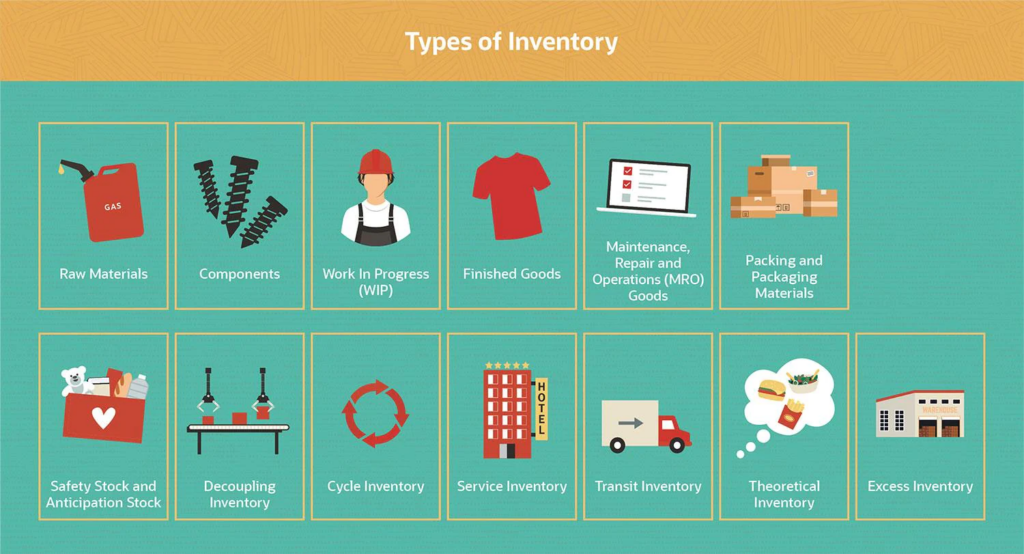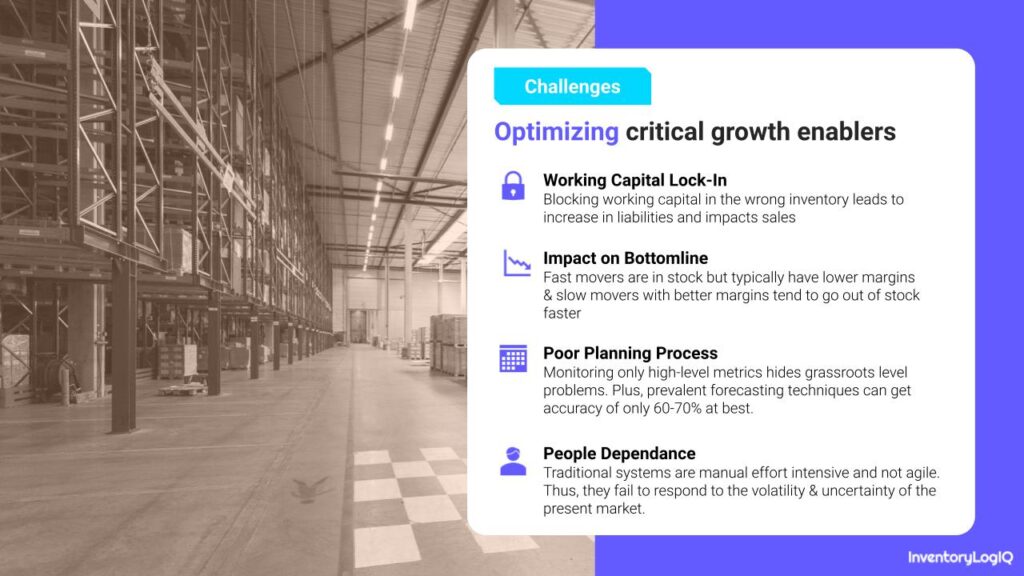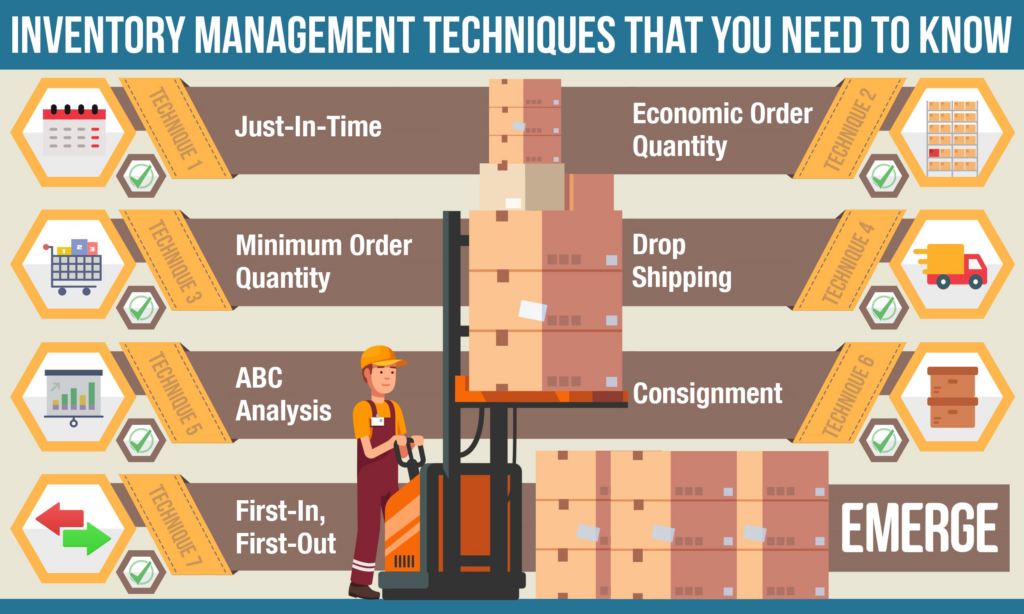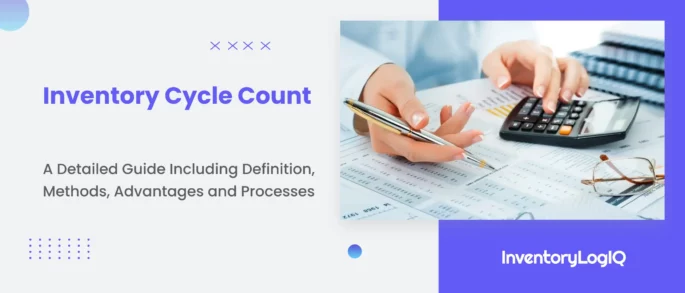What is Inventory Management? Objectives, Challenges, Importance & 10 Benefits of Implementing Inventory Management in 2023
It’s critical to assess your company on a frequent basis to verify that you’re on the right route. Inventory management or Stock management is among the most important aspects of any company.
How has inventory management worked out for your online business? Ever had the proper stock levels when you needed them? Ever lost sales because an item was out of stock? Or did you lose money because you had too much inventory? Address these questions to yourself and in the end, you will be having answers and solutions for your queries.
We also got you covered over some standard practices for managing inventory in this article, as well as fundamentals of inventory management strategies.
- What is Inventory Management?
- What are the Different Types of Inventory to be Managed?
- Objectives of Inventory Management
- 7 Challenges Faced In Inventory Management
- Importance of Inventory Management
- 10 Benefits Of Efficient Inventory Management
- Increased Competitiveness in the Market
- Improved Service Quality due to Lesser Lead Time
- Reduced Storage Costs
- Revenue Growth
- Better Utilisation of Warehouse Space
- Simplified Cost Accounting Tasks Due to Inventory Control
- Safety And Environmental Considerations
- Increased Customer Confidence
- Better Human and Equipment Utilization
- Improved Product Quality
- 10 Benefits Of Efficient Inventory Management
- 7 Step By Step Processes To Implement Inventory Management
- 10 Best Practices Of Inventory Management for Online Businesses in 2023
- Make A List Of Your Inventory’s Top Priorities
- Keep Track of All Product Details
- Examine Your Stock
- Examine the Performance of Your Suppliers
- Follow the 80/20 Rule When it Comes to Inventories
- Maintain a Consistent Approach to Receiving Stock
- Keep Track of Your Sales
- Order Restocks on Your Own
- Invest in Inventory Management Software
- Use Technology That is Easy to Incorporate
- Conclusion
- How Can InventoryLogIQ Aid in Managing Inventory?
- Inventory Management FAQs (Frequently Asked Questions)
What is Inventory Management?
There are many different meanings of inventory. Some people define inventory as the total value of all the things used in your firm. This encompasses anything to do with your business operations, such as business supplies and the security of the products.
We feel that thinking of inventory as the total of all products utilized in your business that are meant for sale is more beneficial. This entails examining all of the components that go into producing your goods. Materials directly tied to your manufacturing process include both goods that are ready to sell and items that you plan to sell in the future.
Inventory management, in its most basic form, is the management of your industrial inventory, often known as product inventory. These are all of the supplies and materials in your warehouse or storage area that are intended for product manufacture. Only things ready to sell, or merchandise inventory, are kept in the inventories of retailers and wholesalers.
However, before going into the intricacies, it’s always a good idea to brush up on the basics or you might end up following others like a blind sheep if you don’t. In this scenario, we need to know not just what inventory is, but also what the goals and objectives of good inventory management for small businesses are. Read our blog on perpetual inventory systems to know more about the methods, benefits & how perpetual inventory is different from periodic inventory systems.
What are the Different Types of Inventory to be Managed?

While handling and controlling stock, a corporation may encounter a variety of various forms of inventory. All of these concepts are crucial to grasp to achieve successful inventory management.
When it comes to the things that a company could sell, there are seven different types of inventory-
Raw Materials
Any goods utilized to make completed products or the separate components that go into them are referred to as raw materials. These can be manufactured or sourced by a company, or they can be acquired from a vendor.
Work-in-progress (WIP) Inventory
Retailers who make their items have work-in-progress (WIP) inventory. These are unfinished or in-progress goods or components that are not yet available for sale.
Finished Goods
The term “finished goods” refers to things that are finished and ready to sell. These might have been produced in-house or obtained as a complete, finished product from a vendor.
Most shops will either buy entire, finished items from a provider or commission a third-party to create unique products for them. As a result, finished items are frequently (but not always) one of the few forms of inventory that require attention in retail inventory management.
Safety Stock
Safety stock is an important inventory categorization that allows producers to maintain planned output levels in the event of an emergency. This sort of inventory is simply a stretch surplus of anything required to finish the manufacture of some or all products, such as raw materials, parts, products, and any other necessary items.
The purpose of safety stock is to guarantee that firms do not experience any production disruptions that result in incomplete items or idle industrial machines. Any substantial delays in finishing and distributing items might result in a drop in income as well as a loss of customer confidence.
The amount of safety stock inventory required will be specific to the items being created, as well as the anticipated demand and supply of the product.
Ready to Sell Inventory
Ready-for-sale inventory products are finished goods that are sitting in warehouses waiting to be dispatched to merchants. This is the amount of ready-to-sell inventory held by a manufacturer or retail warehouse. Nothing prevents these things from being processed, packaged, and dispatched to merchants or straight to customers from the warehouse.
Anticipation Inventory
Anticipation inventory refers to things that are only available at certain periods of the year. Retailers and manufacturers alike must keep a close watch on forthcoming seasons and inventory levels.
Packaging Materials
Everything needed for packaging and delivering items is the final category of inventory that merchants and manufacturers alike cannot disregard.
Pallets, shrink wrap, wooden boards and planks, nails, and everything else needed to properly deliver items to merchants fall under this category for manufacturers.
Bubble Wrap, Styrofoam peanuts, and other cushioning materials, as well as a range of boxes and adhesives, are available to online merchants and retailers who offer delivery.
Objectives of Inventory Management
Objectives of Inventory Management should be both operational and financial. In terms of operations, stored items should be accessible in appropriate quantities, and working capital should be kept to a minimum. The following are some of the most important objectives of inventory management –
Processing the Orders
If you don’t know how much stock you have at your hand, you won’t be able to meet a received order. To fulfil orders, you must have the appropriate items on hand at all times. Otherwise, directives may throw you into disarray.
Assume you’re selling apparel and you’ve gotten an order for 500 men’s denim jeans, but there are only 300 pieces of denim available at the warehouse when you checked out. If the order is received without knowing the stock level at the warehouse, then chaos will follow. An inventory management system should be utilized to avoid this, and team members should be aware of the inventory level.
Having Adequate Supplies
Inventory should be conveniently stocked in advance, from raw materials to completed goods. You should provide enough of the essential material to ensure that items are not harmed when a client requires them.
Supply tracking ensures that goods are available to fulfill client demands. It also allows for the shaping of demand depending on the available supply. After you have adequate supply to match client demand, you create specific targets based on customer demand.
Stock Management
To make things go more smoothly, you’ll need a thorough inventory record. This approach allows you to keep track of your inventory and stops you from making mistakes like duplicating orders or maintaining the wrong quantity of inventory on hand. Situations of overstock or understock should always be considered.
We already know that understocking may lead to shortages and disrupt the ordering process, but overstocking is just as dangerous.
Assume you’re working with perishable goods and have an excess of them. Perhaps you plan to keep such stockpiles on hand as a backup in case of higher-than-usual demand.
However, holding an excessive amount of stocks may create more problems than not being able to satisfy the actual supply and demand. Also holding stocks for too long can spoil the quality of products and may cost you money.
Minimizing Expenses
The basic objective of inventory management is to save expenses as much as possible. To be financially secure, you should reduce superfluous capital. After all, money is a critical restriction. To lower manufacturing costs, you should restrict your investment to a minimum and keep material costs under control.
If the things don’t sell, your assets might become liabilities overnight. As a result, one of the objectives is to guarantee that you do not lose money as a result of holding inventory. Items should be used while their original worth is still intact.
Working capital should be kept to a minimum because it is also required for other activities like operations and sales. When you manage your inventory well, you can avoid extra expenses.
Dealing With Losses
When it comes to coping with losses, managing inventory effectively helps to a great extent. When there is no effective tracking system in place, items are prone to be squandered or misplaced.
Besides, no matter what sort of employment you conduct, theft is always a danger worth addressing.
Keeping a record of things reduces, but does not eliminate, the risk of loss. Having a record on hand eliminates potential waste and protects your firm from theft. Such dangers are heightened in situations when large quantities of items must be handled.
As a result, an inventory management system is a lifesaver when it comes to keeping track of everything and minimizing any losses.
Strengthening Production
Managing your inventory benefits productivity in a variety of ways. When you want to update something in the manufacturing process, having an inventory system makes it easier.
If you wish to grow or downsize your production, look at your tracking system and determine how to lead it.
Furthermore, inventory systems assist manufacturing in running smoothly by assuring an effective supply. Production doesn’t have to be reformed again if you retain your records and have enough supplies.
Product Sales Optimization
Analyzing product sales patterns is another thing you can do with stock management. The phase of sales is crucial to the entire operation. It aids in the comprehension of the existing situation and the formulation of future assumptions based on the analysis. For example – s Sluggish items can be detected and eliminated.
Assume you’re in the business of selling jewellery. Some of your items aren’t performing well in the marketplace. The sales aren’t going as planned, and they’re all sitting on the shelf. Keeping things that are no longer in demand does not appear to be a wise idea.
In that scenario, you may lower the pricing to sell them, or you can find another means to sell them.

7 Challenges Faced In Inventory Management
Every physical product selling firm requires inventory management. Given the volatile nature of the business, managing inventory becomes extremely difficult. A competeCompetentng software may assist you in resolving a variety of issues, including inventory reorder limits, excess inventory storage costs, and many more, which we will go over in further detail later.
The following are the most common issues encountered during stock management.
Unpredictable Tracking
Using manual management procedures across a variety of programming and accounting pages is time-consuming, repetitious, and impotent in the face of errors. Even small businesses can benefit from a solid stock global positioning strategy that includes accounting features.
Because of the uncertain monitoring and invisibility of stock, more than 33% of enterprises will miss a shipment deadline, as they sold an item that wasn’t truly in stock. For a large percentage of businesses, inadequate visibility is a difficult issue to deal with when it comes to inventory management processes, and the results may be disastrous. Improving data collection and inventory analytics by improving your procedures, and equipment as part of warehouse management services helps solve inventory and supply chain concerns.
Transparency
The finest companies will include transparency in their satisfaction to guarantee that reps and clients are aware of what is going on. Request difficulties can occur in any circumstance, even with the special challenges of inventory management in internet purchases. If your client is aware of the delays, they may adjust their expectations and be certain that their item will arrive in the end. Your success depends on your ability to communicate and be honest. This includes informing the client that the second item they are waiting for returns stock.
Poor Operational Processes
At the distribution centre, inventory management controls are escalated actions that include getting and putting away, picking, pressing, and transportation. The goal is to do each of these tasks in the most efficient manner possible.
Inefficient Software
Inventory management programming must combine your present company measure stages to scale to support complicated coordination. Various arrangements and a big group of highlights requiring preparation and progress help are perusing many demand and supply management arrangements and dominating a large number of highlights requiring preparation and progress support
Businesses count specific items in the stockroom rather than totalling the entire stock at once. Cycling calculating is a method of fact-checking. The computation of individual things serves as a type of lens through which the rest of the stockroom may be viewed. You’ll probably see similar inaccuracies in various zones if your stock is wrong in the cycle tallies. Similarly, if your store’s cycle checks verify it’s accurate, you’ll have accurate tallies.
Keeping Track Of Warehouse Space
Managing space effectively is a daunting task. You may better control the situation of new stock conveyances by arranging and organizing stockroom spaces using inventory management stages. It can represent important elements such as available spaces.
Collaboration Between Workers
One of the most common challenges in inventory management is labour cooperation. To guarantee that their eCommerce warehousing process is executed correctly, communication and teamwork are essential. When departments are averse to sharing information, it’s far more difficult to discover inventory patterns and find ways to improve. Employees cannot be informed about tasks, requirements, progress, or work condition if information flow is delayed and disturbed. As a result, firms will face warehouse-related problems.
Production Scheduling
Production planning is critical for reducing production costs and delays. Businesses must summarise their production results each month, identify the problem and its remedy, and set objectives for the next month. Based on the solution and monthly KPIs, they generate detailed production plans. It may have an impact on sales predictions and project timelines if not done appropriately.
Importance of Inventory Management
Inventory Management is an important part of supply chain management, which is the process of keeping track of inventory levels and goods flow, whether it’s providing raw materials to manufacturers or satisfying orders for finished items.
Inventory management is a critical component of a company’s long-term success, as it helps them save expenses, enhance cash flow, and increase profits.
The balance of your supply chain will fall into place once your inventory is correctly arranged. Mis-shipments, shortages, out-of-stocks, spoiling (when dealing with vulnerable inventory stock), excess stock, incorrect pick-ups, and other mistakes are all possible without an effective inventory management system.
Small business owners still don’t track their inventory, and supply chain inventory accuracy in U.S. retail operations is just 60 per cent on average, implying that many merchants aren’t productively managing their inventory.
An Inventory Management system, unlike an enterprise resource planning (ERP) IM system, concentrates on a single supply chain operation. It can link with other software systems, such as POS (point of sale), multi-channel sales management, and branded shipping, allowing you to create a customized integration stack to match your business’s particular requirements.
10 Benefits Of Efficient Inventory Management
Increased Competitiveness in the Market
Inventory control is aided by utilizing efficient ways of managing inventory. In establishing a business’s competitive strength, criteria such as commonalities with values, high factor loadings values, and substantial mean values are taken into account. These reasons unquestionably highlight the necessity of inventory management and control, which increases market competitiveness.
Improved Service Quality due to Lesser Lead Time
It’s still true that managing inventory efficiently leads to repetitive customers, which is something that every firm strives for. If you want your loyal customers to keep coming back to buy your products and services, you must always enhance your service quality so that you can quickly respond to their requests. Inventory management and control assist businesses in fulfilling such demands by allowing you to give the appropriate levels of hands-on service as soon as your clients request it with an acceptable lead time which ultimately emphasizes the necessity of quality stock management.
Reduced Storage Costs
The advantages include concentrating on inventory planning and lowering storage costs while maintaining enough stockpiles. By adopting proper inventory management and control, the factor minimizes storage costs and boosts income, emphasizing the necessity of managing inventory levels. Efficient inventory management help avoid excess stocks or stockouts.
Revenue Growth
Inventory planning may be used to bridge the gap between increasing revenues and lower costs in any firm. A company’s profitability may be increased by using efficient inventory management and control. If a company ignores the advantages of managing its inventory in its trade, sales, and manufacturing, it may find it difficult to maximize its operational efficiency. The cost of procurement and manufacturing of inventory has a significant impact on gross profit. A company’s gross profit can be increased by lowering its manufacturing costs. As a result, appropriate inventory planning is necessary. And, with all things equal, such a corporation would report more revenues, which in turn leads to higher profitability, demonstrating the necessity of inventory management once more.
Better Utilisation of Warehouse Space
Proper management and control entail keeping track of all commodities produced, purchased, and sold to fulfil consumer demand. These inventory management advantages have an impact on the management approach that helps an organization’s warehouse achieve better space management.
It will always be tough to manage your inventory successfully if your warehouse is disorganized. Several firms choose to improve their fulfilment centres by grouping higher-selling items in conveniently accessible sections within the warehouse. This procedure helps to expedite order fulfillment while also ensuring client satisfaction.
Simplified Cost Accounting Tasks Due to Inventory Control
Better inventory management will undoubtedly land you in better financial situations.
Internal plans and measurements are frequently developed by business owners to provide better management and planning of production and sales. Such approaches connect every participant in the firm, including managers, to providing actions that make accounting activities easier. Typically, these tactics assist industries in order, accounting for inventory values, maintaining inventory flow, and assisting in the control of stocks. Several organizations may effectively control their cash flow by using such approaches in inventory planning.
Safety And Environmental Considerations
When employees strain to walk on the shop floor, can’t move things easily, and tumble off the shelves, having too much inventory in the warehouse can be a health and safety hazard.
Efficient stock management results in less packing, which results in less waste generation and helps the environment. This is one of the strongest reasons to emphasize the necessity of inventory management.
Increased Customer Confidence
With improved methods in place, any business may employ inventory planning and management to boost cash flow by delivering better customer service at consistent prices. Small businesses may use an inventory control and planning tool to learn which goods sell well than others. They will be able to change their product range and make informed business decisions as a result of this phase.
Better Human and Equipment Utilization
If steps to control and manage inventory are properly implemented, it saves time in terms of human resources and equipment consumption. Less time spent maintaining inventory translates to improved productivity for both your company and your clients. With these advantages, your company will always be one step ahead of the competition and will always have adequate items on hand depending on inventory movements.
Improved Product Quality
Inventory management and control may help improve corporate efficiency and product quality significantly. These advantages help to reduce waste and improve emphasis on creating quality managing processes.
It is undeniable that having an effective inventory management system leads to greater success and repeat customers. If you want your loyal clients to keep coming back, you must improve the quality of your products in every manner imaginable.

7 Step By Step Processes To Implement Inventory Management
Examine Your Budget
The ABC of inventory process management, the only basis of this approach, is planning and attentively monitoring your budget, as mainstream and widespread as it may appear. It is equally important since it dictates the breadth of your inventory management and the amount of raw inventory you can afford to spend.
This can be accomplished in one of two ways: The first is manual budgeting and activity-based costing (ABC costing), which identifies and assigns a cost to raw materials so that you may plan. The second method is to use budgeting software that is specifically designed for this purpose. You may use it to automate this procedure and have the software assist you in managing your money more efficiently.
Make a Warehousing Plan
After analyzing your budget, the next step is to choose a place. Because some organizations have many sites, the warehouse where your items will be stored and await transportation is critical.
It’s also critical to choose the right storage for your merchandise. Different industries and raw materials necessitate different warehouse types. As a consequence, thinking about it ahead of time might save you a lot of trouble.
The sort of warehouse determines where your high-demand raw materials go, how often they’re carried and shipped, and how much lead time you can provide your customers.
You’ll be able to manage products and reduce logistics costs once you’ve chosen a facility or third-party logistics partner. This can be done manually or with the help of an inventory management solution. You’ll be able to automate activities and make the process of shifting merchandise between various types of warehouses or organizing it in a precise sequence much easier with the latter.
Whether you’re a small, mid-sized, or large business, using Inventory Management software will be less time-consuming and cost-effective than doing it manually.
You’d be able to use it to automatically transfer items from one facility to another and rigorously control the present status of your products.
Make a Preliminary Order List
Create a preliminary order list based on the past level of demand for your items. This is critical since you’ll be able to predict when a piece of your supply will be gone and act quickly to avert such disasters. You’ll also find it easier to create cycle counting if you use this method.
You should be able to start using the Inventory Management program once you’ve figured out the budget, the location, and the most critical items.
Select and Implement The Appropriate Software
Picking the proper tool for you can be a difficult undertaking, thus this is the phase where you should spend the most attention. With each passing day, it becomes increasingly difficult to pick inventory management software due to the plethora of products on the market. As a result, when selecting it, you should consider the following measures:
Decide on a Pricing Range to Work With
Remember what we discussed in the budgeting portion earlier? This is where it comes in handy: there are a lot of wonderful alternatives on the market, but the best one for you will be determined by your price constraints. As a result, you should have a pricing range in mind that you can use to limit your search.
Recognize Your True Requirements
Before you install software, you should know what you’ll be utilizing it for. Different instruments on the market can meet a variety of demands and desires
Are you planning to utilize it to create personalized product pricing? Do you want it to do inventory forecasting based on current stock levels? Or to keep track of orders and monitor every action in your warehouse? You must answer these questions before deciding on an integration option, since the objective may have a direct impact on the tool’s efficiency.
Determine Specific Integrations You’ll Require
It’s critical to select a system that you can combine with your existing apps and tools. Otherwise, you’ll have to manually enter all of this information, which will result in data time delays and data loss, negating the value of acquiring an inventory management system.
As a result, you should be aware that different inventory management software products are appropriate for different circumstances – are you utilizing an Enterprise Resource Planning (ERP) system, a Customer Relationship Management (CRM) system, or something else? So, your choice is strongly reliant on these systems and their ability to work together.
Taking these actions before entering into the deep area of inventory management, you’ll be able to assess your internal demands and determine what you need to accomplish.
However, as previously indicated, deploying such software might be pricey. As a result, even while analyzing the budget, keep in mind that, while it is an exceptionally advantageous option, it may not be appropriate for all small or mid-sized businesses.
You may think of automation software as a supplemental service and do keep these factors in mind.
10 Best Practices Of Inventory Management for Online Businesses in 2023
The most important strategies for efficiently managing your inventory for greater profitability and cash flow management-
Make A List Of Your Inventory’s Top Priorities
Organizing your inventory into priority categories will help you figure out which things you need to purchase more of and more regularly, as well as which are critical to your business but may be more expensive and take longer to move. Experts recommend categorizing your inventory into three categories: A, B, and C. The A category consists of higher-ticket things that you will need less of. Low-cost products with a high turnover rate fall into the C category. The B group consists of things that are modestly priced and move out the door slower than C items but faster than A items.
Keep Track of All Product Details
Keep track of the product details for each item in your inventory. SKUs, barcode data, suppliers, countries of origin, and lot numbers should all be included in this information. You might also want to keep track of the pricing of each item over time so you’re aware of things like scarcity and seasonality that might affect the price.
Examine Your Stock
Once a year, some firms do a complete count. Others do spot inspections on their most popular goods on a monthly, weekly, or even daily basis. Many people engage in all of the aforementioned activities. Make it a habit to physically count your inventory regularly, regardless of how often you do it.
Examine the Performance of Your Suppliers
Your inventory may be harmed by an unreliable supplier. It’s time to take action if your supplier is consistently late with deliveries or consistently under-delivers an order. Talk to your provider about the difficulties and figure out what’s wrong. Prepare to change business partners or cope with erratic supply levels and the risk of running out of goods as a result.
Follow the 80/20 Rule When it Comes to Inventories
Generally speaking, 20% of your stock accounts for 80% of your profits. Make inventory management of this 20% of products a top priority. You should be aware of the whole sales lifetime of these things, as well as how many you sell in a week or month, and keep a constant eye on them. These are the goods that bring you the most money; don’t let them go to waste.
Maintain a Consistent Approach to Receiving Stock
It may seem obvious to ensure that incoming inventory is handled, but do you have a standard procedure that everyone follows, or does each person that receives and processes new stock do it in their unique way? Small inconsistencies in the way new stock is received may leave you scratching your head at the end of the month or year, unsure why your figures don’t match your purchase orders. Ensure that all employees who receive goods do so in the same manner and that all boxes are confirmed, received, and unpacked together, tallied precisely, and checked for correctness.
Keep Track of Your Sales
This may appear to be a no-brainer, but it entails more than simply totalling up revenues at the end of the day. You should know what things you sold and how many of them, and you should keep track of your inventory totals. But you’ll also need to study this information. You should know when particular goods sell quicker or when they become obsolete. Is it a one-time thing or do you sell certain things on a given day of the week? Is it true that certain things usually always sell together? If you can answer these questions, you are on track to know your sales in your business.
To keep your inventory under control, you must understand not only your sales totals but also the bigger picture of how goods sell.
Order Restocks on Your Own
Some suppliers provide inventory reordering services. On the surface, this appears to be a positive thing: you save money and time by delegating the procedure for at least a few of your products to someone else. However, keep in mind that your vendors may not have the same goals as you. They want to shift their inventory, but you want to stock the most profitable things for your company. Take the time to inspect inventory and place reorders for all of your goods.
Invest in Inventory Management Software
It’s possible to manage the first eight items on this list manually, using spreadsheets and notes, if your company is small enough. However, if your firm expands, you’ll need to spend more time on inventory than on your business, or risk having too much stock. All of these activities are made simpler by good inventory management software. Before you pick a software solution, make sure you know what you’re looking for, that it has the metrics you need, and that it’s simple to use.
Use Technology That is Easy to Incorporate
Inventory management software isn’t the only tool you can use to keep track of your supplies. Mobile scanners and POS systems can assist you in staying on schedule. Prioritize systems that function together when investing in technology. It’s not the end of the world if your POS system can’t interact with your inventory management software, but it might cost you time to move data from one system to another, making it easy to wind up with wrong inventory counts.
Conclusion
Regardless of the size of your company, inventory management is essential. It reduces losses, storage expenses, and stock-outs for the firm. These technologies enable you to successfully manage various sites while maintaining accurate records. By recording everything methodically and quickly, an inventory solution saves you time and money; moreover, this strategy promotes customer happiness by eliminating errors along the route and providing them with the best possible experience.
Better customer interactions lead to more successful businesses. As a result, inventory management systems have a significant and favourable impact on overall performance. You can start improving your inventory by finding the correct tool for your firm.
You May Also Read: What is Shopify Inventory Management?
How Can InventoryLogIQ Aid in Managing Inventory?
Inventory planning can be tremendously complex, and if not executed adeptly can lead to a significant loss in sales. To simplify this, InventoryLogIQ uses advanced AI algorithms to generate deep SKU-level actionable insights which will enable you to enhance your inventory turns, and lower RTOs, by placing the right product at the right fulfillment center at the right quantity.

You may tackle inventory difficulties with the aid of InventoryLogIQ’s multifaceted approach. Some of the ways we can assist you are as follows:
Optimizing Your Inventory Management System
Many parties involved in the supply chain have chosen to switch from just-in-time to just-in-case inventory management techniques. In order to prevent stockouts in the event of a disruption, this shift entails stockpiling extra goods. Unfortunately, carrying excess stock increases related storage and handling expenses, and figuring out how much safety stock you actually need can be challenging.
In order to maximise your profits by keeping the right SKUs in stock and avoiding overstocking and out-of-stock situations. InventorylogIQ offers AI-based monitoring software to identify and increase product availability and mitigate potential sales losses through smarter inventory planning.
Optimized Inventory Holding Costs
You won’t have money invested in idly present goods thanks to effective inventory management. InventoryLogIQ helps you detect inventory that moves slowly or that is out-of-date and won’t sell at all, enabling you to get rid of surplus stock and save money on storage costs.
Our analytics and straightforward reports help you find the best products and promotional bundles to sell non-moving goods and cut your inventory holding expenses by up to 40%.

Solutions for Regional Distribution and Fulfillment
Our fulfillment center location suggestion engine analyses regional purchasing trends to help you choose the best fulfillment center faster.
When you integrate our technology with your online business, we help you quickly get up and running. Orders are instantly transferred to the fulfillment facility closest to the order’s destination for picking, packing, and shipping as soon as we receive your goods.
You can track inventory in real time, examine order fulfillment and shipping analytics, estimate demand, and do much more from the InventoryLogIQ dashboard.





